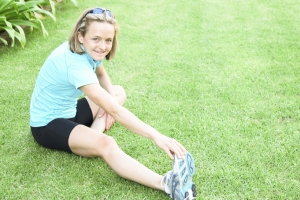Mara Yamauchi blog: Injury prevention is always better than cure
05 July 2014

Running has a lot going for it – it’s simple, inexpensive, and enjoyable. But it can have one disadvantage, namely injuries. You may have heard about common running injuries – plantar fasciitis, runner’s knee, and hamstring tendonitis – and there’s no doubt that the repetitive pounding of every step can put stress on the body to the point of injury.
Photo by marimo images
But it doesn’t have to be so – the human body is very adaptable, and well-equipped for handling the pressure and forces it has to withstand when we run. So if we can give it a helping hand, by treating it kindly and looking out for signs of trouble, then we are much more likely to prevent injuries. Therefore, it’s definitely worth investing time and effort into making sure injury doesn’t stop you from running over the summer.
So where to start? Here are a few quick, practical tips.
- The most important part of a runner’s body is – their behind! Yes, your gluteus (gluts for short), or bum muscles will appreciate being kept in good working order, and will give you no end of grief if they are neglected. Why? In distance running, gluts play several important roles (e.g. stabilising, propelling you forward). But it’s easy for them to become lazy and dysfunctional because endurance runners don’t often sprint, and other muscles (e.g. hamstrings) are always willing to step in and take the load. Glut muscles need to be strong and activating properly, and a handful of simple, regular exercises can help with this. For example, the clam, single-leg bridges, step-ups, and single-leg squats will all ensure your gluts are kept strong and well-conditioned. There are lots of video demonstrations of these exercises on YouTube, or a physiotherapist can explain how to do them correctly. I used all these exercises to recover from a chronic hamstring tendon injury in 2011, and thanks to getting my gluts working again, I was able to qualify for London 2012 and make it onto Team GB.
- Drink or eat something within 20 minutes of finishing training. Immediately after exercise is when your body is most able to absorb nutrients which are critical for the body to repair and regenerate itself. Training causes micro-damage to muscles and other tissues, and stimulates the body to build itself up stronger. But it can only do this properly if you give it the fuel and fluid it needs. The best post-training fuel for injury-prevention is a recovery drink consisting of protein, carbohydrate, minerals and vitamins.
- Listen to, and learn about your own body. Everyone is an individual, and we are all prone to certain injuries depending on how we run, our anatomy, and our daily habits. But if you know you are prone to certain injuries, you can take steps to address that and prevent them recurring. My right foot has been my nemesis throughout my career, but I’ve learned to keep it in good health through targeted exercises, using gel heel cups in my shoes, and stretching my calf muscles religiously.
- Finally, stretching after training is crucial for returning your muscles to their resting state and accelerating your recovery before the next training session. If you find you are always rushing onto the next thing after a run and your stretching gets neglected, it’s worth finishing your run 5-10 minutes early to ensure that you stretch, no matter what.

If, despite your best efforts, you find yourself injured, there are many therapists who can help, from osteopaths and physiotherapists, to masseurs and the good old GP. But using your own common sense to prevent injury in the first place, is by far the best way to keep yourself on the road and enjoying our wonderful sport!
Mara Yamauchi is a retired British marathon runner with a personal best of 2:23:12 set in the 2009 London Marathon, a time which ranks her as the 2nd fastest British female marathon runner ever. Mara is also a qualified Run England group leader and Athletics Coach.
Mara's previous blogs: Stepping up to 10K or half marathon; Beginning running check list
Photos by marimo images
More news from RunTogether




